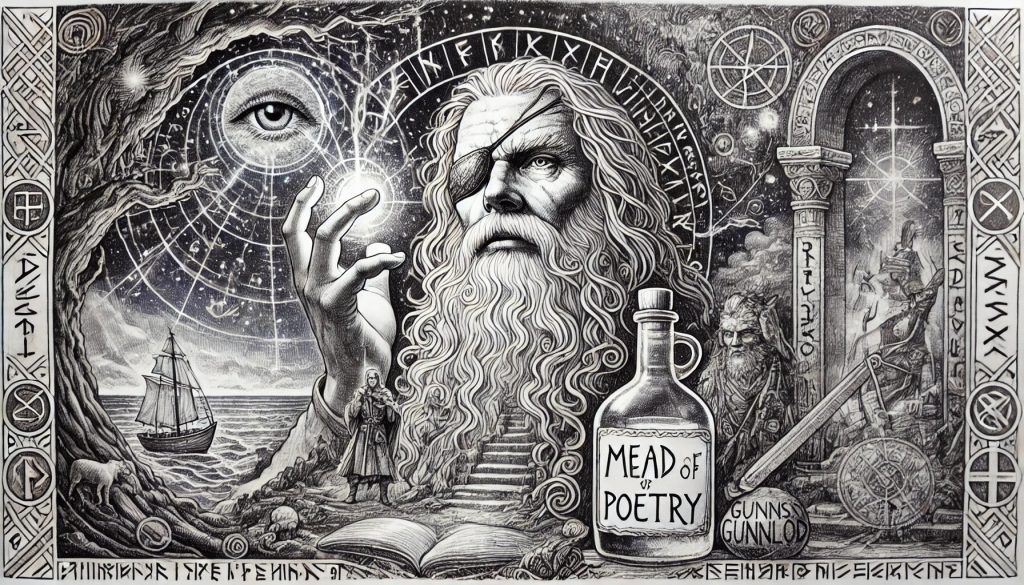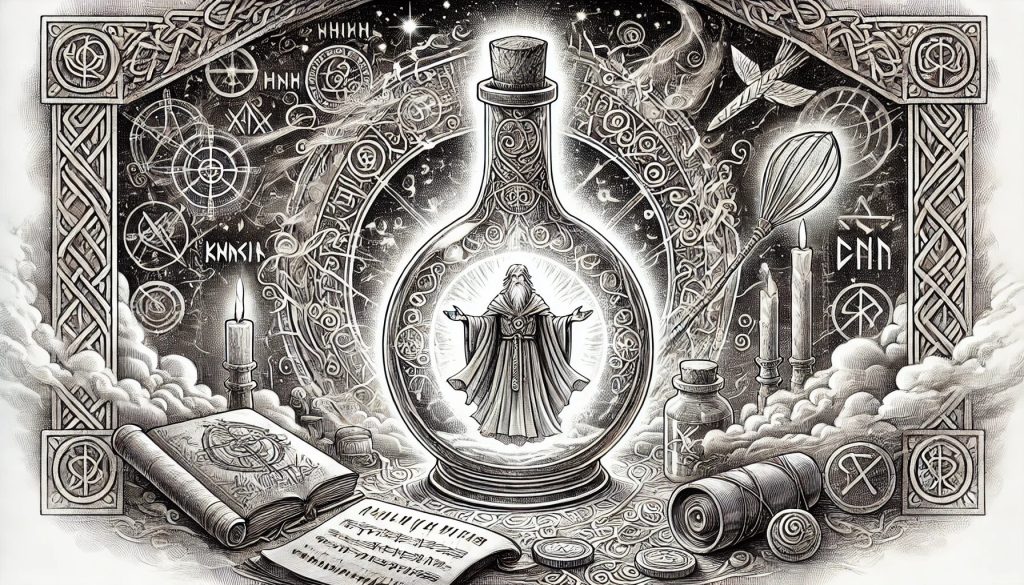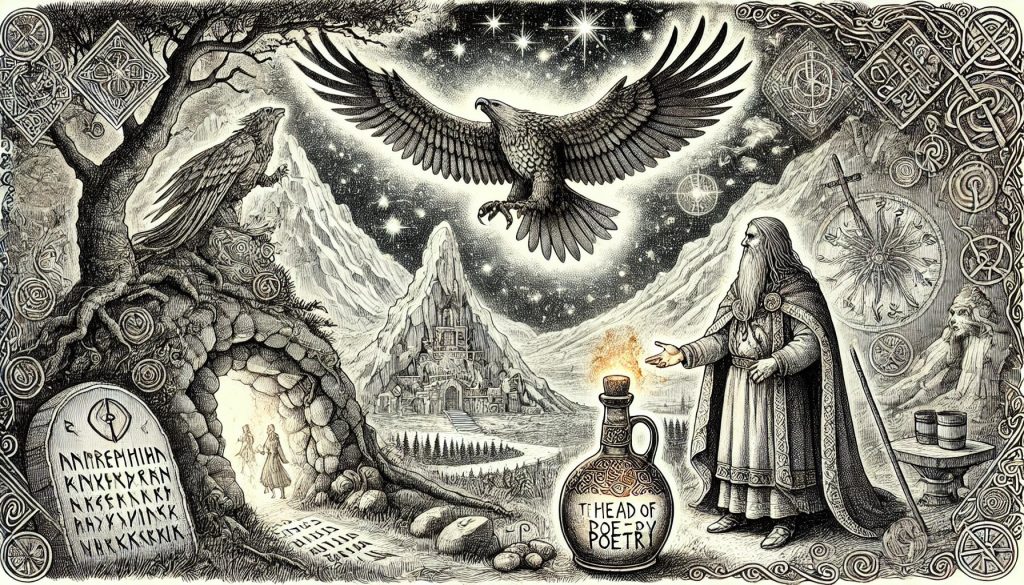Aesir Gods, Kvasir, Norse Gods, Norse Mythology, Odin, Tales of the Gods
The Mead of Poetry
In Norse mythology, a tale of a magical drink called the Mead of Poetry unfolds, a story chronicled by Snorri. This drink, full of Nordic lore, gives wisdom and inspiration to those who drink it. It starts with Kvasir, a wise being, and goes through the clever dwarves and Odin’s brave quests.
The Mead of Poetry is at the story’s core. It stands for creativity and the love for knowledge. The story of Kvasir, Odin, and Mead’s guardians shows how much we all want to be enlightened and how powerful poetry can change us.
Introduction to the Mead of Poetry
In Norse mythology, the Mead of Poetry is a key story. It’s a magical drink made from the gods’ spittle that ends their fight. Kvasir, the wisest being, played a big role in its creation.
The feud between the Aesir and Vanir gods led to the Mead of Poetry, originally crafted by the two dwarves. They made peace and mixed their saliva to create Kvasir. This being was full of wisdom and showed the power of working together.
Kvasir was incredibly smart and knew a lot. His spittle turned into the Mead of Poetry. Drinking it lets people write amazing poems and be very poetic.
- The Mead of Poetry shows how the Aesir and Vanir gods came together thanks to a truce.
- Kvasir, the wisest being, came from their combined saliva, symbolizing peace.
- The Mead of Poetry, made from Kvasir’s spittle, gave drinkers great poetry skills and wisdom.
This story of the Mead of Poetry shows how important wisdom and creativity are in Norse myths. It also reminds us of the good things that come from making peace and seeking knowledge.
The Birth of Kvasir
In Norse mythology, Kvasir’s story is fascinating. He was born from the gods’ saliva after they made peace, making him the wisest being, full of knowledge.
Everyone wanted to talk to him because he could answer any question. His wisdom was so great that even the gods came to him for advice.
But his life was short-lived, as the tides of fate turned against him. The dwarves Fjalar and Galar killed him by choking him. They wanted to stop him from being more powerful than them.
After his death, the dwarves kept his blood. They knew it could make the Mead of Poetry, a drink that gives inspiration and a great speech, named Kvasir after its origin.
The Creation of the Poetic Mead
In Norse mythology, the Mead of Poetry was made with the help of Kvasir, a wise being. Kvasir was born from the gods’ saliva and was known for his deep knowledge. But, his wisdom led to a plan by dwarves Fjalar and Galar.
Kvasir’s Blood Becomes the Mead
The dwarves Fjalar and Galar wanted the Mead of Poetry for power. They tricked Kvasir into a trap and killed him. They then used his blood, full of wisdom, to make the Mead of Poetry.
They kept the blood in a special vat. This mead became a treasure hidden by the dwarves. It was a source of inspiration and creativity sought by many.
The Mead of Poetry, made from Kvasir’s blood, changed Norse mythology and led to events that affected both the gods and mortals.
The Dwarfs Fjalar and Galar
In the tale of the Mead of Poetry, Fjalar, and Galar, two clever dwarves, play a key role. They helped make the famous poetic mead that the gods later wanted.
The Cunning Scheme of the Dwarves
Fjalar and Galar met Kvasir, a being full of wisdom, and saw a chance to gain power. Kvasir, born from the gods’ saliva, was known for his vast knowledge. The dwarves planned to get his blood to gain power.
They invited Kvasir to their home and killed him. They took his blood and mixed it with honey, offering to sharpen their scythes in exchange. This made the Mead of Poetry a drink of great power.
But their evil plans didn’t stop there. They also plotted to kill the giant Gilling and his wife using a scythe and a whetstone. This act made them even more powerful over the mead.
Fjalar and Galar showed how far they would go for the Mead of Poetry. Their actions show the power and charm of this mythical drink.
The Giant Suttung and the Hidden Mead
The story of the Mead of Poetry takes a new turn with the giant Suttung. He got his hands on this precious drink after some interesting events. The dwarves Fjalar and Galar, famous for their clever tricks, had first gotten the Mead of Poetry from a millstone. This drink was made from the blood of the wise Kvasir.
Suttung’s Guarded Treasure
Suttung, a powerful giant, got the Mead of Poetry as payment for his father Gilling’s death. He knew how valuable and powerful this drink was, more than just a tide of inspiration. So, he kept it hidden deep in a mountain, watched over by his daughter Gunnlod.
This drink, full of Kvasir’s blood, was priceless. Suttung wanted to keep it safe from thieves. His strong mountain and Gunnlod’s watchful eye made sure no one could take it.
Now, a big challenge was coming. The god Odin was going to try to get the Mead of Poetry. This drink, kept by Suttung, was very sought after. Its future would greatly affect poetry in Norse mythology.
Odin’s Quest for Wisdom
Odin wanted knowledge more than anything. He set out to find the Mead of Poetry, a drink that gave wisdom and inspiration. Suttung kept this treasure, which he got from Kvasir, the wisest being in Asgard.

Odin’s Cunning Disguise
Odin didn’t let the challenge stop him. He came up with a clever plan. He dressed up as a traveler and met Baugi, Suttung’s brother. He promised to do a hard job for a taste of the Mead of Poetry.
Odin’s cleverness shone as he talked his way past Baugi. Then, he turned into a snake to go through the mountain tunnel. Coming out, he found himself in front of Gunnlod, Suttung’s daughter, who watched over the Mead with an auger in hand.
Odin’s quest for wisdom led him to Suttung’s home, but this was just the start of his amazing journey.
The Seduction of Gunnlod
In the tale of the Mead of Poetry, Odin wants wisdom and sets his sights on a guarded treasure. He plans to get the mead by seducing Gunnlod, Suttung’s daughter. She has the key to the elixir.
Odin’s Bargain with Gunnlod
Odin, a wise and clever god, meets Gunnlod with his charm. He convinces her to let him have the Mead of Poetry. Odin promises to stay with her for three nights and take only three sips of the mead.
Gunnlod is won over by Odin’s charm and promises. She doesn’t see the trickery coming. Odin uses his charm to get closer to his goal during those three nights.
As the last night comes, Odin is more determined than ever. He knows getting the mead and leaving before Suttung finds out is key. Odin uses his strategy and cunning to make his move, constantly sharpening his plans.
The Great Escape: Odin as an Eagle
Odin stood before the guarded entrance to Suttung’s mountain, ready for action. He had already tricked the giantess Gunnlod, and now he aimed to escape with the Mead of Poetry. This elixir was key to his plan.
Odin’s Transformation and Flight
Odin turned into a mighty eagle, spreading his wings wide. He flew high above Asgard, carrying the Mead of Poetry in his talons. He knew he had to leave fast before Suttung found out.
As he flew towards Asgard, Odin felt the Mead’s weight in his claws. He knew Suttung would soon realize his treasure was gone. Odin had to get to Asgard fast to share the Mead with the gods.
With a burst of speed, Odin reached Asgard’s gates. He changed back into his true form and gave the Mead to the gods. The Aesir celebrated Odin’s cleverness and bravery. He had gotten the elixir and outsmarted Suttung, who had guarded it with an auger.
The Distribution of the Mead
The wise and powerful god Odin returned to Asgard with the Mead of Poetry, the result of his clever and bold adventures. The Aesir, the gods and goddesses of Norse mythology, eagerly waited for Odin. They knew the mead could inspire and empower poets, bards, and anyone seeking eloquence.
Sharing the Mead with the Gods
Odin presented the Mead of Poetry to the gods of Asgard with great respect. The Aesir, including mighty Thor and wise Frigg, all tasted the divine nectar. As they drank, they felt a burst of creative energy. This energy sparked their imaginations, giving them the power to create beautiful verses and melodies.
The sharing of the Mead of Poetry was a big event. It started a new time of artistic expression and poetic inspiration in Norse mythology. Odin, the Allfather, had achieved his goal. The gods could share their wisdom and creative ideas with those seeking the divine muse.
- Odin presented the Mead of Poetry to the Aesir gods and goddesses.
- The Aesir, including mighty Thor and wise Frigg, each partook of the divine nectar.
- The gods felt a surge of creative energy as they drank, igniting their imaginations.
- The distribution of the Mead marked the beginning of a new era of artistic expression and poetic inspiration.
Symbolism and Themes in the Tale
The story of the Mead of Poetry is full of deep symbols and themes. It explores wisdom, inspiration, and the strength of poetry. At its core, the mead is a magical drink that brings out the spark of creativity and enlightenment.
Wisdom, Inspiration, and the Power of Poetry
The mead of poetry holds the spirit of Kvasir, the wisest being in Norse mythology. It shows how knowledge and art come together. Kvasir’s blood turns into a powerful drink that gives poets their inspiration, a secret held by Snorri.

The story is full of clever plans by dwarves and giants, showing how much they value this magical drink. Odin’s journey to get the mead, his trick to win the giantess Gunnlod, and his daring escape highlight its deep meaning. The mead is seen as a source of unmatched wisdom and creative power.
This tale shows how poetry and the arts deeply affect the lives of gods and humans. The mead of poetry proves the power of words to change lives. It gives those who use it the power to go beyond what’s known and dive deep into human feelings.
The Legacy of the Mead of Poetry
The story of the Mead of Poetry has deeply influenced the world of Norse mythology and inspired many poets, bards, and artists over the years. This legend, full of deception, sacrifice, and the quest for knowledge, still moves and affects people today. It shows the lasting impact of creativity, wisdom, and the power of words.
The Enduring Influence of the Mead
The Mead of Poetry is a key part of Norse literature, known for its complex story. It has touched many lives, being reimagined and celebrated by artists and writers for centuries. Its story goes beyond mythology, influencing many creative works.
The Mead of Poetry has sparked countless creative pieces from old Nordic tales to today’s interpretations. These works offer fresh views on wisdom, inspiration, and how words can change us. Poets and bards often use its symbols in their poems, and artists bring its epic story to life with their art.
The Mead of Poetry’s impact is clear in its effect on Nordic literature and art. It has moved beyond its original culture, becoming a symbol of creativity and the quest for knowledge. Its ability to adapt and endure has made it a global symbol of the creative spirit.
The Mead of Poetry still inspires poets, bards, and artists today. Its legacy shows the lasting power of myths and their ability to express the human experience in all its depth and beauty.
Conclusion: Wisdom and Inspiration in Norse Mythology
The story of the Mead of Poetry shows us the lasting impact of myths and legends. It highlights the power of wisdom, creative inspiration, and the arts and reflects deeply on what makes us human.
In Norse mythology, the Mead’s journey is a key part of its tale. It moves from divine origins to being secretly kept and then back to Odin. This story speaks to our deep desire for knowledge and creative expression. The Mead of Poetry symbolizes enlightenment and artistic genius, still inspiring us today.
As we end this captivating story, we value Norse mythology more than ever. The Mead of Poetry reminds us of our quest for wisdom and artistic expression. It shows how our minds can create, innovate, and leave a lasting impact on our world.

